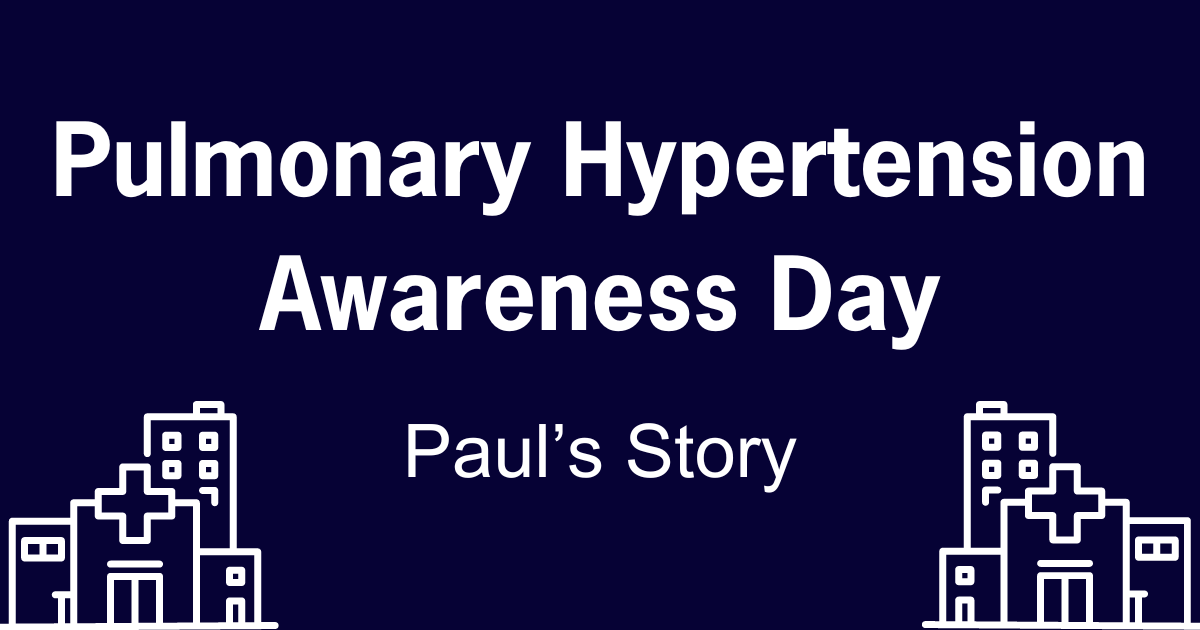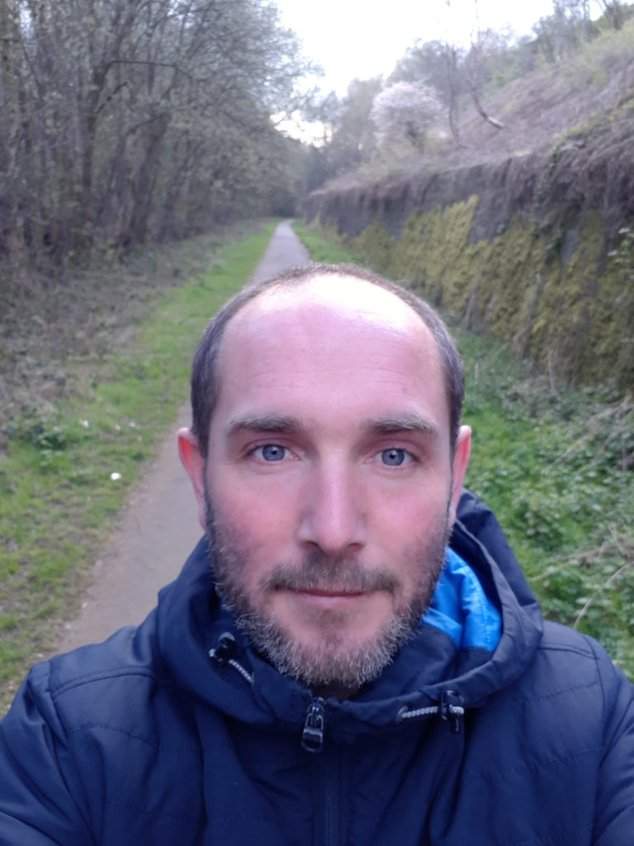
For Pulmonary Hypertension (PH) Awareness Day on the 5th of May, we take a look at what PH is and we share Paul’s story who has been living with Pulmonary Arterial Hypertension for over 9 years.
What is it?
The NHS states that Pulmonary hypertension is high blood pressure in the blood vessels that supply the lungs (pulmonary arteries). It is a rare and serious disease, with only around 8,000 people in the UK being diagnosed with PH.
PH causes the pulmonary arteries (those that connect the heart to the lungs) to become thick, stiff and/or blocked by blood clots. When this happens, there is an increased strain on the right side of the heart as it tries to pump blood through tight, scarred, or blocked arteries. This means there is reduced blood flow into the lungs which is essential to circulate oxygen to all the other cells in the body. This can cause people with PH to experience severe breathlessness , other symptoms listed by Pulmonary Hypertension Association UK (PHA UK) include:
- Chest pain
- Feeling tired or dizzy
- Swelling in the ankles, arms or stomach area
- Fainting
Although the PH is serious and life impacting, many people with PH feel frustrated as their condition may seem invisible to others. PHA UK states that PH is a serious medical condition, and should not be confused with hypertension (high blood pressure). It affects people’s abilities to carry out basic tasks and get around, and it can affect their emotional wellbeing too.
PH can affect anyone, regardless of gender, age or ethnic background and there are 5 main types of PH. These are:
Group 1: Pulmonary Arterial Hypertension
Group 2: Pulmonary Hypertension Due to Left Heart Disease
Group 3: Pulmonary Hypertension Due to Lung Disease
Group 4: Pulmonary Hypertension Due to Chronic Thromboembolic Pulmonary Hypertension (CTEPH)
Group 5: Pulmonary Hypertension Due to Unknown Causes

Currently, there is no cure for PH but there are various treatments which will be offered depending on what type of PH a person has, and what is causing the severity of the symptoms.
Paul’s Story
Paul works at Shaw Trust and has been living with Pulmonary Arterial Hypertension for over 9 years. In order to spread awareness of the disease, we asked him to share his journey to diagnosis and treatment.
I was diagnosed with the autoimmune disease Systemic Lupus Erythematosus (SLE) in 2002 at the age of 21 and had minimal rheumatoid flareups. In 2015 I was diagnosed with another autoimmune disease, Systemic Scleroderma. The two autoimmune diseases are collectively known as Mixed Connective Tissue Disease (MCTD) which in turn, caused Pulmonary Arterial Hypertension (PAH).
In the months leading up to diagnosis, I was increasingly becoming breathless and had feelings of discomfort on daily dog walks at ever decreasing distances. I was admitted to my local hospital and within two weeks, I deteriorated and admitted to the Intensive Care Unit (ICU) with heart failure. After researching all that she could, my wife suggested to doctors that I could additionally have Scleroderma causing PAH and at this point, I was diagnosed! I was transferred to a PH Specialist Centre a few hours away from home. I stayed for three months, supported by my wife for the whole duration who visited me daily and stayed in the patient’s accommodation, with family visiting at weekends.
I had the WHO functional class of Four (This is the most severe class of PH. It describes how the patient may suffer from symptoms even at rest) and spent the first month going from bed to chair only. Within the first two months I was admitted to ICU on three occasions. After three months, I was discharged with a Hickman Line which was inserted into my heart and connected to a pump containing the medication to help relax my blood vessels. After two nights at home, unfortunately, the line became infected with MRSA and I was admitted back into ICU at my local hospital and transferred back to the PH Specialist Centre. I stayed here for another month and the decision was made to remove my Hickman Line and instead I was discharged with a Nebuliser containing the same medication.
My life changed drastically - I went from being a Training and Recruitment Manager, to being unable to work and claiming sickness benefit and Personal Independence Payment (PIP). Over the next two years, I became self-employed before going back into full-time, permanent employment. Nearly ten years on, I have been working at Shaw Trust for the last three and a half years and I am now a Learning and Development Trainer and Apprenticeship Lead.
Today, my PAH is stable and have a WHO functional class of Two with shortness of breath doing normal activities, taking daily medications to relax blood vessels and to delay disease progression. At the beginning, acceptance was difficult but now, progressing into my tenth year, it is how PAH affects me mentally with the feeling of burden that it has on my wife and family.
Throughout my time with PAH, I have been supported immensely with the invaluable expertise from the team at Pulmonary Hypertension Association UK (PHA UK) who are the only charity in the UK supporting those with PH (PHA UK homepage).
My advice for people who have been diagnosed PH is not to ‘Dr Google’ and to seek accurate and reliable information. Accepting and adjusting to PH can be challenging. At the start of my journey, I accessed Talking Therapies on several occasions and Cognitive Behavioural Therapy. It is important to talk to those in your circle, if they don’t know, they don’t know; but it was also important for me to speak with professionals to help ‘offload’ the things in my head and to manage my thoughts and feelings.
Personally, my sporting days are behind me regardless, and I exercise now by going on walks. I may not be able to go on long walks, but I can manage shorter distances, have a rest and go again. I have found new hobbies and interests to keep me active with my allotment which is a five-minute walk from my home. I often visit just to sit for a bit of ‘head space’ and mindfulness. A quote from a favourite film, Ferris Buller’s Day Off, “Life moves pretty fast. If you don't stop and look around once in a while, you could miss it.”

Treatments for Pulmonary Hypertension have come a long way, and the average life expectancy has risen significantly. According to PHA UK, some treatments for PH can help improve symptoms and some may slow disease progression and reverse damage to the heart and lungs. However, PH is still a rare disease and there is still a lot to achieve in finding a cure.
We hope you have found this article helpful and informative. It’s important to note that this article has not been written by a health care professional and if you are experiencing pain or any of the symptoms above, please do speak to your GP.
To view the sources listed in this article please click on the bold and underlined text. You can also find them listed below.
- NHS – Pulmonary Hypertension
- Pulmonary Hypertension Association
- Systemic Lupus Erythematosus